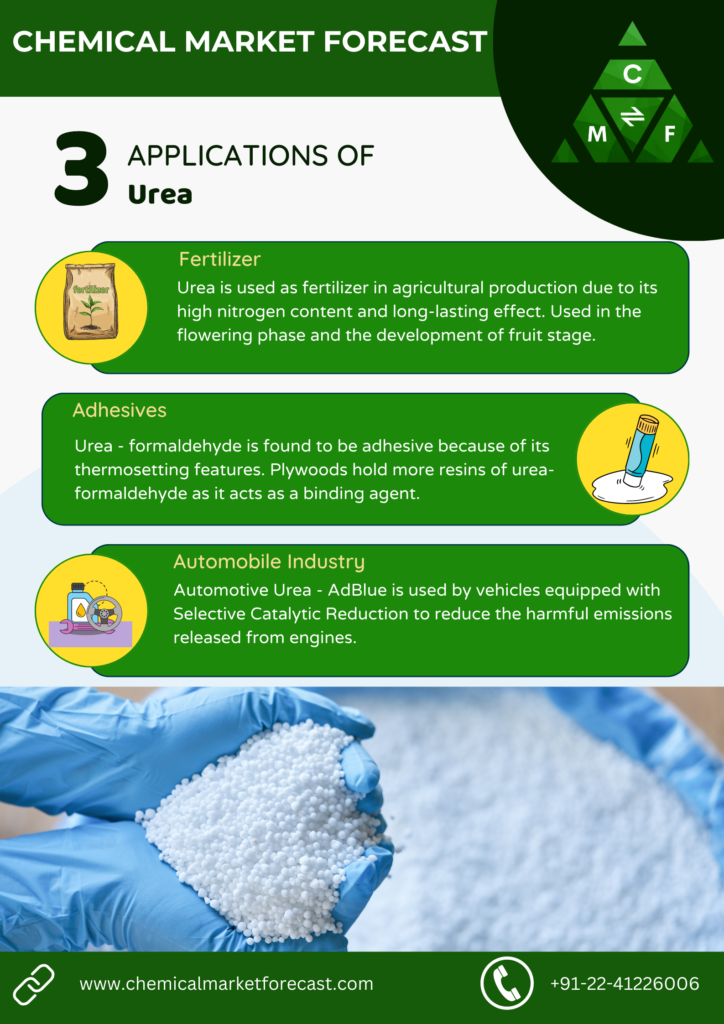Introduction
Urea market is highly competitive, with numerous key players operating globally. Urea is otherwise known as Carbamide (H2NCONH2 ). It is the nitrogenous by product of mammal’s and a few fishes’ metabolic breakdown of proteins. Other than the usage as a fertilizer, Urea is also utilized to make polymers and pharmaceutical products. The amino groups from the amino acids that make up proteins are naturally eliminated during the protein breakdown. Then, ammonia is produced from those amino groups. The liver converts ammonia into urea because it is extremely harmful to the human body. The urea is then expelled as urine after passing through the kidney. Urea is a colorless, odorless, non-toxic, soluble substance that is neither acidic nor alkaline. Synthetic urea is used as fertilizers for agricultural purposes. Here we focus on the global market of Urea, its recent trends and the challenges, opportunities faced by the industry.
Historical Background
In 1828, a German chemist “Friedrich Wohler”, pioneer of organic chemistry discovered the synthetic urea. It is created from synthetic ammonia and carbon-dioxide, it can be produced as a solid as well as liquid. The usage of the synthetic urea emerged as it is used as a fertilizer in agriculture, as well as in the chemical industry like plastics, adhesives etc.
Current State of the Industry
The global urea market’s production value was noted to be 175.59 Million Tones around 2022. The primary driving factors of the urea market are the expanding agricultural industry, increase in the utilization of Urea as a fertilizer. The Urea market can be fragmented into fertilizers, feed and technical grade. Currently, among these three, technical grade dominates the market.
Major Application areas
As of 2022, Agriculture dominated the largest market share of the global urea market. Large-Scale use of Carbamide as fertilizers increased the crop yield. The global urea market has been divided into nitrogenous fertilizer, stabilizing agent, keratolyte, resin, and others based on application. Among these, nitrogenous fertilizer today has a certain market domination. One of the main causes of the demand for Urea (CH4N2O) to increase soil fertility and crop productivity globally is the expanding worldwide population and the ensuing rising need for food.
Emerging Trends in the Industry
Stamicarbon has created a new mega plant idea to reduce urea fabrication costs through economies of scale. This design (4500 mtpd) is based on known process stages, and the required high pressure equipment sizes will not exceed those required for a 3250 mtpd pool condenser-type CO2 stripping urea plant. The plant will be outfitted with a medium pressure recycling stage, which will eliminate the need for a separate ammonia recycle loop while benefiting from the low water content in recycle carbamate created at medium pressure, resulting in greater conversion numbers and lower steam use.
Recent Developments in the Industry
Urea is driven by the increasing use of fertilizers in agriculture, especially in developing countries, to enhance crop productivity. In terms of M&A activity, in 2021, EuroChem, a leading global fertilizer company, completed the acquisition of Agricola Bulgaria, a Bulgarian fertilizer distributor, to expand its presence in the region. In terms of research, scientists at the University of Cambridge have developed a new way to produce Urea using a combination of sunlight and urine, which could provide a sustainable and affordable source of fertilizer for developing countries. Overall, the Urea market is expected to continue growing in the coming years, driven by increasing demand for food and the need for sustainable agricultural practices.
Opportunities and Challenges
Opportunities
Urea and its derivatives are widely used as fertilizers in most areas, including North America and India. The growing demand for N-fertilizers to promote plant development is driving up the urea market. Furthermore, because of the product’s increasing use in the region’s agricultural sector, developing countries such as those in South Asia and Latin America are expected to have higher-than-average demand for it. Because of its multiple industrial applications, carbamide has recently seen a major surge in demand from the manufacturing industries. It can trap diverse chemical compounds since it has the ability to establish hydrogen bonds that interpenetrating helices. Because of its property, it can be used to separate the mixture and create aviation fuels and lubricating oils and separation of paraffin. In the vehicle sector, the chemical is utilized to reduce nitrogen oxide emissions caused by petrol combustion. BlueTec solutions, for example, inject aqueous solutions into the exhaust system. Ammonia in a catalytic converter converts nitrogen oxide emissions into water and nitrogen.
Challenges
Growing consumer preference for eating organic fruits and vegetables is reducing the need for urea in fertilizers for large-scale agricultural production. Biological fertilizers and ecological pest controls derived from plant and animal wastes are used in organic farming in the agricultural system. In organic farming, it is forbidden to use an artificial and synthetic fertilizer that is utilized for commercial purposes. The growth of seeds, seed germination, and early plant growth in soil are all negatively impacted by the overuse of fertilizer in commercial farming. It’s possible for fertilizers to burn when too much urea drains water from plant roots. The production of inefficient and environmentally harmful ammonia by plants can be limited by urea.
Conclusion
The industry is facing a steady growth from the increasing demand of agriculture. To overcome the challenges faced by the industry, the companies started investing more in R & D to improve the production. Due to reasons like population expansion, urbanization, increased food demand, and the need to boost per hectare land production, the global urea market is expanding significantly. However, considerations like environmental controls implemented because ammonium-based fertilizers like urea emit ammonia gas are somewhat impeding industry expansion.

